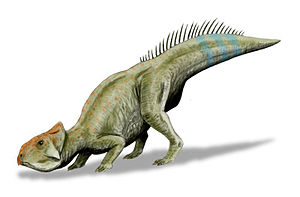Leptoceratops
| Leptoceratops | ||||||||||||
|---|---|---|---|---|---|---|---|---|---|---|---|---|

Live reconstruction of Leptoceratops |
||||||||||||
| Temporal occurrence | ||||||||||||
| Upper Cretaceous (Upper Maastrichtian ) | ||||||||||||
| 69.9 to 66 million years | ||||||||||||
| Locations | ||||||||||||
| Systematics | ||||||||||||
|
||||||||||||
| Scientific name | ||||||||||||
| Leptoceratops | ||||||||||||
| Brown , 1914 | ||||||||||||
| Art | ||||||||||||
|
Leptoceratops is a genus of pelvic dinosaurs (Ornithischia) from the group of Ceratopsia , within which it iscountedto the Leptoceratopsidae .
features
Leptoceratops was a small, agile dinosaur that reached a length of 1.2 to 2.7 meters. The skull was large and massive, but unlike some other late Ceratopsia, it had no horns. As with most of the higher Ceratopsia, there was a neck shield made of parietal and scale bones , but this was relatively flat and small. The beak was pointed, and the teeth, like all Ceratopsia, were adapted for a plant-based diet. The front legs were very short, this dinosaur is likely to have moved mostly biped (only on the hind legs).
Discovery and naming
The fossil remains of Leptoceratops come from North America and were first described by Barnum Brown in 1914 . Finds were made in Alberta (Canada) as well as Wyoming and Montana (USA). So far, three complete skulls, two partially preserved skulls and parts of the body skeleton are known. The name is derived from the Greek words leptos (= "thin") and keratops (= "horny face"), a common part of the Ceratopsia name. The type and only recognized species is Leptoceratops gracilis .
The finds are dated in the late Upper Cretaceous (Upper Maastrichtian ) to an age of 69 to 66 million years.
Systematics
Originally Leptoceratops was incorporated into the Protoceratopsidae , but today it is the namesake of the Leptoceratopsidae , a group of Ceratopsia that is primarily or exclusively limited to North America.
literature
- You Hailu, Peter Dodson : Basal Ceratopsia. In: David B. Weishampel , Peter Dodson, Halszka Osmólska (eds.): The Dinosauria . 2nd edition. University of California Press, Berkeley CA et al. 2004, ISBN 0-520-24209-2 , pp. 478-493, digitized version (PDF; 807.25 kB) .
- David E. Fastovsky , David B. Weishampel: The Evolution and Extinction of the Dinosaurs. 2nd edition. Cambridge University Press, Cambridge et al. 2005, ISBN 0-521-81172-4 .
Individual evidence
- ^ Gregory S. Paul : The Princeton Field Guide To Dinosaurs. Princeton University Press, Princeton NJ et al. 2010, ISBN 978-0-691-13720-9 , pp. 253-254, online .